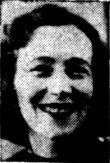The daughter of Queensland-born commission agent and part-time singer (tenor) Frederick Herbert Mendoza and his Victorian-born wife Phoebe (née Herman), Doris Rosetta Elizabeth (Dot) Mendoza was born in Perth on 11 September 1899. Between ca. 1907 and 1911 she was a student of Kalgoorlie juvenile music and performance teacher Mrs Bennett-Wilkinson (aka Mrs R. A. Bennett). She reportedly excelled in her practical piano examinations and also accompanied her father in concerts. In the Australian Dictionary of Biography Jane E. Hunt records that Mendoza was 'musically versatile… skilled at sight-reading, playing melodies by ear, and transposing on sight' (n. pag.).
After the family moved to Melbourne she began lessons with the Melbourne music teacher Edward Goll (ca. 1912) and at age 17 won a Melbourne University Conservatorium scholarship. At a mid-winter concert in Melbourne in 1917 her selections from the Grieg Concerto were reportedly played with "Brilliant technique and grasp of the Norwegian writer's intentions." The Punch critic went on to note that Mendoza's performance was 'one the maturest readings of the evening' (26 July 1917, 8). In 1919 Mendoza successfully auditioned as a rehearsal pianist for J. C. Williamson's Ltd. She later toured with Anna Pavlova (Australia and New Zealand,1926), Bavignoli (Australia, 1928), and the Williamson Opera Company (New Zealand, 1932).
Mendoza is believed to started her association with popular culture entertainment (variety theatre and film exhibition) in the late-1920s. In 1929, for example, she performed piano duos with Stephanie Grey during the Comedy Theatre's Brewster's Millions season. Their repertoire, performed prior to the screening and during the intermission, comprised selections from opera, musical comedy, Gilbert and Sullivan, National music, and popular songs from England, Ireland and Scotland. In 1931 she performed with Cecil Parkes (violin) and Christine Fraillon (cello) at the Café Chantant, Melbourne, playing selected numbers and accompanying leading singers. The event was staged under the direction of Hugh Steyne.
The early 1930s saw Mendoza appear in radio concerts broadcast out of Melbourne, continue performing as 'between films' entertainment (notably at the Majestic Theatre in 1933), and feature at various charity concerts. In 1933, for example, she appeared on the bill at Gladys Moncrieff's fundraiser for the Melbourne Women's Hospital. Also on the programme were artists such as James Foran and Claude Flemming. The latter half of the decade saw Mendoza tour with the Madge Elliott-Cyril Ritchard Company (1935), and Colonel Wassily de Basil’s Ballet Russe (1936-1940). She is believed to have made her first radio appearance in 1935 accompanying members of Ritchard's High Jinks company in a special live outdoor broadcast from the Perth Esplanade
She also appeared in a variety concert for the Goodwood Orphanage in Adelaide in 1937. Other artists on the bill were fellow members of J. C. Williamson's Over She Goes Company, Kitty Bluett, and the Pot Shot Revue Company. A 1936 article on Mendoza indicates, too, that she had previously been associated with tours by international artists such as Toti dal Monte (soprano), Italian conductor Rossi, as well as Boucicault and Moscovitch ('Pianist's Cavalcade of Colourful Folk.' News 15 Oct. (1936), 7.
After World War II Mendoza became involved with Sydney's Minerva Theatre and made at least three recordings with Columbia Records. She was also involved in a project to rejuvenate Tasmanian theatre in late 1950. Shortly afterwards she travelled to Britain to visit her children and receive treatment for osteoarthritis. While in there she did some work for the British Broadcasting Corporation.
From the mid-1950s onwards Mendoza worked primarily, as a creative artist, in revue, children's musicals and radio, while also establishing herself in Sydney as teacher (piano and singing) and coach (voice). During the late 1950s and early 1960s, she was heavily involved with the Phillip Street Theatre as composer, music director, and pianist for its revues. Mendoza wrote most of the music for such shows as Alice in Wonderland (1956), Cross Section (1957), Bats (1958), The Birthday Show (1959), Stop Press (1961), and At it Again (1962). She also performed in some productions and was the musical director of the revue Is Australia Really Necessary? (1964).
In the mid-1960s Mendoza was associated with The Mavis Bramston Show as scriptwriter, composer and performer. Jane Hunt further notes that "she wrote the score for The Vatican, a sound recording that included material from Vatican radio as well as dramatisation by Australian actors… [and] coached actors in performance and voice production. Among those she taught were Barry Humphries, June Salter, Gordon Chater, John Meillon and Jill Perryman. Dot Mendoza was awarded an OAM in 1985. She died on 19 May 1986 in her home at Mount Waverley, Victoria, and was cremated. She was survived by her daughter June and son Peter.
[Source: Australian Variety Theatre Archive]
 4352697322747943618.jpg
4352697322747943618.jpg